Cosmos bipinnatus



Soft wooded
No secondary (woody) tissue being formed. The texture is fleshy and is soft, easy to cut.
Spreading-ascending
When a plant has stems that gradually grow upwards.This colourful annual to perennial plant has upright weak vertical stems that form a bushy habit. It has thin mid green lobed leaves and the bright white, pink to red wheel-shaped flowers appear above the foliage from summer to
autumn.
Cosmos bipinnatus is naturally found in Mexico, North America growing in disturbed soils and fields. It prefers a in well drained organic rich moist fertile to poor sandy to loamy soil and tolerates chalky soils, that are neutral to alkaline with a pH range from 6.0 to 7.5. It grows in an open to wind protected sunny position and is frost tender but drought tolerant.
Cosmos is grown for its upright habit and colourful flowers. It is planted in annual beds or along borders for its colour and is grown in small or cottage gardens. It establishes in one season and is suitable for coastal or inland regions. The flowers may be used in floral arrangements and there are many cultivars with contrasting colours available. Once established it has a high water requirement (Scale: 3-drops from 3), preferring to have reliable moist organic rich soil for optimum growth.
I.D. 241
UK hardiness zone H6
Climate zones 1 - 24
USDA Zone 8-11
Cosmos (KOS-mos) bipinnatus (bi-pin-AH-tus)
'Cosmos': order; 'bipinnatus': having bipinnate leaves.
Cultivars
'Sea Shells'
This plant has pink to white flowers and the ray florets may curl into a tube.
'Orange Flare'
This plant grows to 1.2m (4 ft) tall with vivid orange single flowers.
Plants that grow to 1.5m (5 ft)
'Bright Lights'
Flowers are yellow orange and red.
'Diablo'
Flowers are fiery reds with yellow centres.
'Double Peerless'
Flowers are double crested in reds pink and white.
Plants that grow to 2m (6 ft)
'Cardinal'
Flowers are single and dark red.
'Dazzler'
Flowers are single in crimson colour.
'Lady Lennox'
Flowers are a large single, in pink colour.
'Mannoth Single'
Flowers are single in red pink and white.
'Purity'
Flowers are pure white.
'Radiance'
Flowers are in pink and red.
Asteraceae (ass-ter-AY-see-ee)
(Compositae)
Sunflower Family
This family is recognised by several features the florets are clustered in the flower head, inferior ovary has one basal ovule and the stamens are connate around the style.
Distribution
This family is found throughout the world except Antarctica. In Australia they are found in arid and semi-arid regions covering large areas.
Diagnostic Features
There are numerous growth forms from small annual herbs, ephemeral, biennial or perennial rosette plants, shrubs but rarely creepers.
The leaves do not have stipules and may be arranged opposite or alternate with margins that are entire to deeply lobed. The texture may be leathery or succulent and may be reduced to spins or needles.
The simple flower is in a tight inflorescence with many florets that sit on a fleshy receptacle that is surrounded by many involucral bracts. In some genera the bracts are reduced or not present and the receptacle may be in an elongated form giving it a club-shape inflorescence.
Each flower has an inferior ovary normally with a colourful corolla on top with the calyx reduced to scales, bristle or hairs around the corolla.
Three distinctive Floret Types
1. Disk florets are funnel form corolla tube that has five equal lobes with fertile stamens and ovary.
2. The ligulate florets with a corolla that is split down one side and the limb formed is extended to form showy ray florets. These flowers are unisexual.
3. The filiform florets come from disk florets when the corolla tube is a slim cylindrical shape and these are normally unisexual.
The fruit produced from the different types is normally a cypsela (type of achene) although some florets don't produce fruit.
The corolla has five petals, which are five lobes in disk florets but are not easily seen in other types.
The stamens are arranged alternate with the petals and the filaments are normally fused to the corolla tube with the anthers arranged around the style in a connate form.
When the pollen falls onto the closed stigma the style elongates above the stamens and then the stigma opens to be pollinated.
The ovary is inferior with one chamber and one ovule and forms a one seeded fruit, which is really an indehiscent fruit (cypsela). These are normally distributed by animals with barbs formed by the pappus and some by wind.
Note:
This is one of the largest families but with low economic importance. They are used in the horticulture industry largely for cut flowers and in the case of sunflowers for seed oil. Many species are grown in domestic gardens and many have become weeds that are wide spread throughout the world.
This plant tolerates between USDA zones 8a to 11a and grows to 2 m (6 ft)
Fahrenheit 10º to 45º F
These temperatures represent the lowest average.
Celsius -9.5º to 7.2º C

Attention
The information displayed on this plant is based on research conducted in our horticultural library and from reliable online resources. We also make observations of the plant that we photograph, and all care is taken to ensure the details are correct.
All photographs and data are covered by copyright. Apart from any fair dealing for the purpose of private study, research, reference or review, as permitted under the Copyright Act, no part including images and text may be reproduced by any means without written permission. The information presented on the map is only indicative and may contain errors and omissions. All inquiries should be addressed to sales@plantfile.com attention Peter Kirkland.

Compound
The leaf that is divided into separate units (leaflets).
Pinnate
A compound leaf that ends in a single or double leaves.
Opposite
Leaves that are arranged opposite to each other.
Entire
A leaf margin with no irregularities (smooth).
Tubulate
A flower that forms a tube shape.
Capitulum
Sessile florets on a flattened and expanded apex (a daisy-like flower). Ray florets can be absent.| Jan | Feb | Mar | Apr | May | Jun |
| Jul | Aug | Sep | Oct | Nov | Dec |
The 70 mm (2 2/3 in) wide radiate flowers have broad soft and fluted ray florets and yellow disk florets. They appear solitary or are arranged in a panicle that appears from early to late summer. They are available in single or semi-double and normally with yellow center.
Note; The compressed inflorescence is called the capitulum or flower head and is composed at the base with a receptacle (involucre) that has one to several rows of bracts that may be spiny. The bisexual or unisexual flowers are attached to the receptacle. The ray florets have a corolla tube that is slit along one side with a Ligule (single petal) normally extend out around the rim giving the flower head a daisy-like appearance. (May be absent in some genus) There are many tubular disk florets in the centre of the flower head and they have 3-5 equal lobes.


Achene
It is a one-seeded indehiscent fruit with a thin pericarp and normally arranged in groups."| Jan | Feb | Mar | Apr | May | Jun |
| Jul | Aug | Sep | Oct | Nov | Dec |
The small seeds self sow easily and there are about 175 per gram. The seeds are viable but the plant may be reproduced vegetatively. Seed heads are normally removed to prolong flowering period.
Cosmos is grown for its upright habit and colourful flowers. It is planted in annual beds or along borders for its colour and is grown in small or cottage gardens. It establishes in one season and is suitable for coastal or inland regions. The flowers may be used in floral arrangements and there are many cultivars with contrasting colours available.
Sow fresh seed during early spring in boxes and pricked out when large enough to handle. The seeds may be sown directly to prepared bed and thinned out as required and it takes 4 to 5 months to produce flowers. Frost protection is required for perennial species and cuttings may be taken from the base.
When planting out, space 300 mm (12 in) to 400 mm (16 in) apart.
Propagation by Seed (General)
Germination
In order for a seed to germinate it must fulfil three conditions.
1. The embryo must be alive (a viable seed).
2. The seed must have no dormancy-inducing physiological, physical or chemical barrier to germination; also the seed must be nondormant.
3. The seed must have the appropriate environmental requirements, water, temperature and oxygen.
The interaction between these requirements and dormancy is complex and may lead to different environmental requirements that avoid the dormancy of a seed.
Sowing Seeds in Containers
There are two general methods for germinating seeds.
1. Sowing seeds in a flat or germinating bed, through which seedlings are pricked-out then, transplanted into another flat with wider spacing or directly to an individual pot.
2. Sowing seeds by placing them in to flats with the appropriate spacing or into individual pots.
This method is normally carried out with medium to large seeds such as woody plants and plants that are difficult to transplant.
Seedling production normally occurs in a greenhouse / glasshouse, cold frames and on hot beds.
Method of Seed Sowing
Fine seed is sown in pots or flats that are no deeper than 70 to 80 mm. using a sterilised well-drained media (soil). Fill the container to 20 mm from the top and sprinkle sieved peat to 3 mm depth.
Press the media down level and firm with a piece of timber and then thoroughly moisten.
Mix the fine seed with washed sand and then sow thinly on the surface. These may be lightly covered with sand.
Larger seeds may be covered with media or a hole is dibbled and the seed is placed in the media.
Watering Methods
For watering you may either mist the containers from above or place the container in tepid water and allow the water to raise through the pot to the surface of the media, then drain away and do not fill to the top of the container.
Place a piece of glass over the pot and store in a protected warm environment (glasshouse).
Seeds germinate best in darkness so shade the containers if in direct sunlight.
After the seedlings have sprouted remove the glass and ease the seedlings into direct light.
When the seedlings are large enough prick them out and transplant into larger containers then place them in a shade house to harden off.
Many seeds have different methods of seed preparation for germination such as nicking or cutting the seed coat to allow water penetration, also placing seeds in hot water and allowing it to cool off.
This is particularly important as it is softening the seed coat.
Asexual Propagation (Cuttings general)
Propagation from cuttings is possible because every cell of a plant containers the genetic information to create an entire plant.
1. Reproduction occurs through the formation of adventitious roots and shoots.
2. The uniting of vegetative parts with budding and grafting.
3. Taking stem cuttings and layering is possible due to the development of adventitious roots
4. Root cuttings can form new shoots and it is possible to join roots with shoots to form a new plant.
5. A new plant may be formed from a single cell in an aseptic culture system, (cloning).
It is important to propagate vegetatively as this form of cloning retains the unique characteristics of the cultivars or where particular aspects of a plant may be lost if propagated by seed.
Equipment Required for Taking Cuttings
1. A sharp knife that is not too large or a razor mounted in a handle.
2. Good pair of sharp secateurs that is clean.
3. A dibbler to make a hole in the media and allow the cutting to be placed in.
4. Propagation structures that are either a timber frame with glass or polyethylene cover or a glasshouse.
The object of the structure is to create an environment where the temperature and humidity can be controlled. This can be achieved with a simple cover over a pot with a wire frame and plastic.
This stops the draughts and maintains humidity.
5. A hotbed is a useful item as many plants root more quickly if the media is slightly warmer.
Bottom heat is obtained from thermostatically controlled heating cables that are running under the media.
6. Misting systems are of great benefit to cuttings as the regulated fogging with water inhibits the cuttings from drying out and as a result the cuttings may be grown in full sun.
This results in faster root development and less subject to diseases by fungi and bacteria.
7. Rooting mediums
The rooting medium must be well drained, sand may be used as long as it is thoroughly washed and leached of all salts. It is very well drained and it is excellent for cutting that root up quickly. Equal parts of sand and peat moss have good results for cuttings, which are left for a period of time to allow the roots to form.
Vermiculite and perlite are also used as a well-drained rooting media but has the same disadvantage as sand having no nutrients. The cuttings must be potted up as soon as the roots developed, or a light application of liquid fertiliser can be applied.
Types of Cuttings
Stem cuttings
These are the main types of cuttings.
1. Softwood cuttings
These cuttings are taken from young growth on side shoots and tip growth.
2. Semi hardwood cuttings
These cuttings are taken from wood that is firmer and semi ripe usually during mid summer.
3. Hardwood cuttings
These cuttings are taken from mature wood normally towards the end of the season.
4. Root cuttings
Cut sections of roots to obtain new plants during late winter to early spring.
5. Leaf cuttings
Cut the leaf blade in order to obtain new plants during the growing period of the plant.
Cutting preparation
Hardwood cuttings
When taking hardwood cuttings remove the leaves and in semi hardwood reduce the number of leaves by half. Cut the wood straight across just below a node or joint. Hardwood cuttings are normally between 100 to 760 mm long and may have either a heel of the older wood attached to the base, or a short section of the older wood at the base. These cuttings are prepared during the dormant season from late autumn to early spring and are made up from previous season's growth.
This type of cutting is used for woody deciduous plants such as Crepe Myrtle, Rose rootstocks and some fruit trees.
The cuttings should be healthy wood with ample supply of stored food as to nourish developing roots and shoots and placed in the rooting media with the aid of a dibbler stick.
Softwood cuttings
The cuttings for softwood should be 60 to 130 mm long and be of material with enough substance as to not deteriorate before the new roots appear. Cut below a node and retain the leaves on the upper portion. Place in a well-drained media and maintain a high humidity.
Soaking the cuttings and leaving them standing in water for long periods is undesirable.
Herbaceous cuttings
These cuttings are taken from succulent plants such as Geraniums and Coleus. The cutting should be 70 to 130 mm long with leaves retained on the upper end. As in softwood cuttings these require an environment of high humidity. Some fleshy cuttings ooze sap and may require a drying period for a few hours before being placed in the rooting media.
Leaf cutting
In these cuttings a leaf blade and petiole or part off is used to raise a new plant. The original leaf doses not become a part of the new plant as roots and shoots appear from the base of the leaf. In some cases roots appear from the severed veins.
Leaf-Bud cuttings
These cuttings incorporate a leaf, petiole and a small piece of the stem. These cuttings are an advantage where the plant uses the axillary bud at the base of the petiole for new shoot growth and maximises available propagation material, as each node will produce a new plant.
As in softwood cuttings these require an environment with high humidity and warmth.
Root cuttings
These cuttings are best taken from younger plants during late winter to early spring prior the new season's growth unless the dormant period is during summer.
Trim the roots as they are dug up and to maintain polarity cut strength at the crown end and a slanted cut at the distal end (away from the crown).
Root cuttings of small plants are placed in flats in lengths of 20 to 50 mm and laying horizontally on the surface of the soil. These may be lightly covered with sieved sand or media, watered and then placing a piece of glass or polyethylene over the container till roots / shoots appear.
Fleshy root cuttings
These cuttings should be 50 to 75 mm long and placed vertically in a well-drained sand media.
Keep the polarity correct and when the roots develop transplant the cuttings into a separate container.
Large root cuttings
These cuttings are 50 to 150 mm long and are tied up in bundles and placed in boxes of damp sand, sawdust or peat for about three weeks at a temperature of 4. 5 deg C. When taken out they should be planted in a prepared bed 50 to 80 mm apart with the tops of the cuttings level with or just below the soil level.
PEST
NAME
Aphids
Various Aphid Species
ORDER
Hemiptera
FAMILY
Aphididae
Description of the Pest
The common name varies and aphids may be referred to as black fly, greenfly, ant cows or plant lice.
These small insects have soft globular body that is from 1mm to 8mm long and vary in colour from green, yellow, black and pink, with the winged forms being elongated. Both adult and nymphs, have piercing and sucking mouthparts.
Aphids are found on buds, flowers, or leaves and stems, preferring soft new growth. On older leaves the aphids are found in protected positions, such as under the leaf. Certain species of aphids form galls as they suck sap and may be found on the roots of the plant. (E.g. Woolly aphids and Black peach aphids)
Most aphids possess a pair of characteristic tubular projections, known as cornicles; these secrete a pheromone and a waxy fluid, which is thought to protect them from some of their predacious enemies.
White exoskeletons, honey dew and sooty mould indicate the presence of Aphids
Balsam Twig Aphid (Mindarus abietinus) is greenish and covered in a white wax and is normally found on the young shoots of conifers bending and killing the needles. It is found on Abies and Picea species.
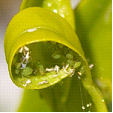 Aphid and their exoskeletons
Aphid and their exoskeletons 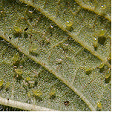 on underside of a leaf
on underside of a leaf
Black Citrus Aphid (Toxoptera aurantii) has a soft plump green body and the black coloured adults may or may not be winged. They feed in groups, curling leaves and producing honeydew attracting sooty mould.
Green Peach Aphid (Myzus persicae) is a soft plump green insect up to 0.2mm long and may be wingless. The nymphs are yellowish green and are responsible for spreading viruses in Dianthus species.
Spruce Gall Aphid (Chermes abietis) form cone shaped galls up to 12mm long resulting from the feeding. The wingless female adult lays eggs on the stems and the immature females overwinter on bud scales. Large infestation will weaken trees such as Picea abies and Pseudotsuga menziesii.
Tulip Bulb Aphid (Anuraphis tulipae) is small, waxy grey coloured and infests the underside of the bulb scales or rhizomes. They occur in the ground or on above ground parts and during storage.
Life Cycle
These insects have a Hemimetabolous life cycle, i.e. The nymphs resemble the adults.
During spring all eggs produced hatch as female nymphs. Adult Aphids are capable reproducing without fertilisation. The males are only produced in some species as the weather cools down, and the day length shortens.
Aphids are capable of giving birth to living young and large populations build up quickly during summer. Over crowding causes the aphids to become smaller, less fertile and produce more winged forms that can migrate to other host plants.
There are many different types of aphids and the life cycle varies from warm to cold climates.
Typical life cycles

Distribution of the Pest
World wide
Period of Activity
In warm climates they are seen throughout the year, but aphids dislike hot dry or cold conditions and heavy rain will decrease the population. In cold areas aphid eggs are laid around a bud base or other protected areas of the plant during autumn and emerge as nymphs during spring, feeding on the new growth.
Numbers build up quickly in the warmer months of the year. Some species feed during winter on Sow thistles.
Susceptible Plants
There is a wide range of plants attacked, from roses to vegetables, shrubs and trees. Certain aphids attack a specific genus while others have a wide range of host plants. Many are capable of transmitting plant virus diseases.
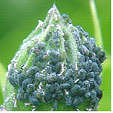 Adults and nymphs feeding
Adults and nymphs feeding 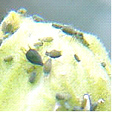 A colony of aphids
A colony of aphids
Acer species are attacked by several aphids including the Norway Maple Aphid (Periphyllus lyropictus) which is a greenish with brown markings and secret honeydew, preferring Acer platanoides. Other aphids include (Drepanaphis acerifolia) and (Periphyllus aceris) which are commonly found on the underside of leaves.
Acer species are also attacked by the Woolly Maple Aphid (Phenacoccus acericola) which covers the undersides of the leaves with a cotton-like mass
Alnus species are infested with the Alder Blight Aphid (Prociphilus tessellates) which is blue-black adult that forms woolly masses on the down-turned leaves. The nymphs overwinter in bark crevices.
Aquilegia species are attacked by several aphids including (Pergandeidia trirhoda) which is a small, flat cream coloured insect that is found on young branches and the underside of leaves.
Betula species may be attacked by the European Birch Aphid (Euceraphis betulae) which is small and yellowish or the Common Birch Aphid (Calaphis betulaecolens) which is large and green producing ample honeydew for sooty mold to grow on.
Callistephus species may be attacked by the Corn Root Aphid (Anuraphis maidi-radicis) causing the plant to become stunted, the leaves wilt and turn yellow. The aphids feed on the roots producing honeydew and are dispersed to other host by ants. It is also attacked by the Potato Aphid (Macrosiphum solanifolii).
Carya species are attacked by Gall Aphids (Phylloxera caryaecaulis) which is found on the leaves, twigs and stems forming galls and turning them black.
Chaenomeles and Gladiolus species, new growth and leaves become infested with the aphid (Aphis Gossypii)
Cupressus macrocarpa may become infested with the Cypress Aphid (Siphonartrophia cupressi).
Cyclamen species are attacked by the aphid (Myzus circumflexus) and (Aphis gossypii) which can infest healthy plants.
Dendranthema, Dianthus and Crocus species are attacked by several types of aphid including the Green Peach Aphid (Myzus persicae) and the Chrysanthemum Aphid (Macrosiphoniella sanborni).
Hibiscus species are attacked by the aphids (Aphis craccivora) and (Aphis gossypii), both congregate towards the branch tips and may cause leaf curl. Normally only seen in sub-tropical climates.
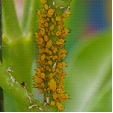 Aphids on a stem
Aphids on a stem 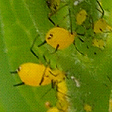 Mandevilla species
Mandevilla species
Larix species is attacked by the Woolly Larch Aphid (Adelges strobilobius). The winged adults deposit eggs at the base of the needles during spring and white woolly areas appear attached to the needles where the adult aphids feed. The young aphids overwinter in the crevices of the bark.
Mandevilla species is attacked by aphids that congregate towards the branch tips and may cause leaf curl.
Pinus species is attacked by several species of aphid including Pine Bark Aphid (Pineus strobi), Pine leaf Aphid (Pineus pinifoliae) and the White Pine Aphid (Cinara strobi).
Primula species are attacked by four species of aphid including foxglove, and green peach aphid.
Rudbeckia, Delphinium, Chrysanthemum and Helianthus species are attacked by a bright red aphid (Macrosiphum rudbeckiae).
Sorbus aucuparia is affected by the Rosy Apple and Woolly Apple aphid which attacked the foliage and young shoots.
Spiraea species are attacked by the Aphid (Aphis spiraecola) which feeds on the young shoots and flowers.
Tropaeolum species are attacked by the Black Bean Aphid (Aphis fabae), which is found in large numbers on the underside of the leaves, turning them yellow and causing them to wilt then die.
Tulipa, Iris, Freesia, Gladiolus and Zephyranthes species are infested with the Tulip Bulb Aphid.
Ulmus species are infected by two types the Woolly Apple Aphid (Eriosoma lanigerum), which curls and kills young terminal leaves and the Elm Leaf-Curl Aphid (Eriosoma ulmi) which occasionally attacks the trees.
Viburnum species are attacked by the Snowball Aphid (Anuraphis viburnicola). This aphid congregates at the end of the branches causing the leaves to curl and become deformed under which they hide.
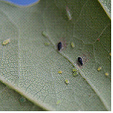 Aphids on Quercus robur
Aphids on Quercus robur
Damage Caused
Buds that have been attacked may not open, leaves and twigs become twisted or distorted and wilt. The aphids also produce honeydew, which is sticky and attracts sooty mould (fungus). This fungus forms a thick layer over the leaf, fruit or stems reducing the plants photosynthesis capability. The sooty mould spoils the plants appearance and its fruit, as does the insects white exoskeletons.
Control
Cultural Control
Aphids may be removed from a plant by hosing them off with water (limited success) or applying soapy water to aphids.. Another organic sprays can be efficient in controlling aphids. Aphids may also be removed physically by hand for small colonies on spine less plants. Species that live under ground are difficult to control but cultivation of the surrounding soil may help in controlling the infestation. (limited mainly to annual or commercial crops)
Reflective mulch around the plants also reduces numbers by repelling the insect this material is available commercially. (Reflective mulches are mainly used in market gardens for avoiding the Green peach Aphids) Resistant rootstocks are available to avoid some root feeding aphid of commercial plants, e.g. Vines and fruit trees
Biological control
Aphids are attacked by several insects includes parasitic wasps or predators such as ladybirds/ lady beetles, hover flies, lacewings, spiders.
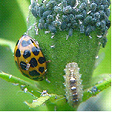
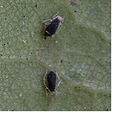 Parasitised aphids
Parasitised aphids
Chemical Control
Aphids may be controlled by spraying with a contact or systemic insecticide. The type of application used will depend on the plant is being attacked.
Aphids can be suffocated and therefore controlled with the use of e.g. White oil, Pest oil, Soapy water from soap such as Lux Flakes ®
Note
It is your responsibility by law to read & follow the directions on the label of any pesticide
Monitoring
Aphid are attracted by yellow colour and traps such as boards painted yellow and covered in glue or sticky substance will attract and trap the insects. There is also a commercially sticky yellow tape that can be attached to susceptible plants
Amendments by B. Sonsie Dip Hort Sc Burnley
PEST
NAME
Slugs and Snails
Various Snails Species
Description of the Pest
Slugs and snails are land molluscs. Snails produce an external spiral shell; slugs do not. The common garden snail Helix asperasa, grows up to 25 mm, long. Its body is slimy, broad, elongated and greyish, with two pairs of reticulated tentacles, with eyes at the ends of the longer pair. The mouth parts of snails and slugs contain a file-like organ known as the radula, which is used to rasp away at the host plant's tissue. Movement of the animal is by a muscular sliding movement, along a slippery trail of mucous; this solidifies on exposure to the air (typically described as a "silvery trail").
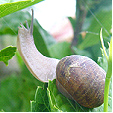
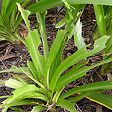
Appearance and Distribution of the Pest
Slugs and snails occur world-wide. Slugs tend to be more prevalent in heavier soil types.
Life Cycle
These insects have a Hemimetabolous life cycle, ie. When the immature nymphs resemble the adults.
Snail eggs are laid in moist soil, 20-40mm deep; eggs are white, spherical and appear in clusters of 30-100. Under favourable conditions, eggs hatch in 2-3 weeks. Newly emerged snails resemble tiny adults. When the weather is cold and dry, snails seal themselves into their shells where they survive, dormant, for 1-3 years.
Period of Activity
More active during the warmer months, although some species may remain active throughout the year.
Damage Caused
Native Australian slugs and snails are not commercial pests. Introduced species chew holes in foliage or skeletonise leaves; some plants may be completely defoliated plants; tubers and seedlings may be completely eaten. Slugs and snails feed mainly at night, especially after rain or watering; they shelter in cool, moist locations during the day. When the weather is dry, snails seal themselves into their shells with a mucous membrane, where they survive, dormant, for 1-3 years. Some species may consume up to one third of their body weight each day.
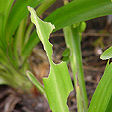
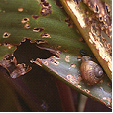
Susceptible Plants
A wide range of leafy plants, including ground crops, potatoes, tubers, leafy vegetables and seedlings.
Fern species are attacked causing serious damage. New fronds are repetitively eaten causing the plant to become stunted. Attacks are normally more severe during wet periods during which time control measures should be taken.
Morinda citrifolia is attacked by the Giant African Snail (Achatina fulica) which defoliates trees.
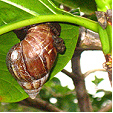

Cultural Control
Remove possible hiding places and avoid overhead watering to reduce humidity. Cultivate soil regularly; in commercial situations, allow the soil to remain fallow for one season to reduce numbers. Domestic infestations may be removed by hand. Traps may be created by inverting small pots near where snails and slugs are feeding; they will gather in these shelters during the day, and may be collected and destroyed. The popular Australian "beer trap" consists of a vertically-sided container, sunk into the ground and filled with beer, which intoxicates and drowns the snails.
Biological Control
Natural predators such as birds, frogs, and lizards reduce numbers, but do not provide effective control. Orchardists have used running ducks to control snails with some success.
Chemical Control
Commercial baits - molluscicides - made from methiocarb or metaldehyde are effective when used in combination with sanitation. Their effectiveness varies according to soil and weather conditions; it is generally recommended to avoid watering after application.
Note
Always read the label for registration details and direction of use prior to application of any chemicals.
PEST
NAME
Thrips (General)
Various Thrip Species
ORDER
Thysanoptera
Description of the Pest
There are many species of thrips that attack living and dead plant material. The winged adults are black, yellow, white or brown with slender bodies and up to 2mm long. The folded fringed wings appear as silvery stripes and the smaller nymphs are difficult to see, but are wingless simular to the adults. Both adults and the first two nymphal stages have rasping and sucking mouthparts.
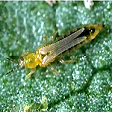 Thrip species
Thrip species
Boree Gall (Kladothrips species) adults are gall producing thrips that form smooth bubble-like or irregular spiny growths on the leaves. These galls can contain up to 1000 insects that also reproduce inside, and are trapped until the gall dries or splits open. Commonly found in inland areas attacking the phyllodes of Acacia species.
Glasshouse Thrips (Heliothrips haemorrhoidalis) is a slender up to 15mm long with small fringed wings. The adult lays eggs on the underside of leaves where the nymphs emerge as miniature adults but wingless. Then feed on the soft leaves leaving a silvery mottled appearance.
Appearance and Distribution of the Pest
Thrips are found from tropical to temperate regions preferring a cool mild winter followed by a dry sunny spring that produces abundant flowers and new foliage. It is dispersed by flying and can be carries great distances on the wind.
Life Cycle
These insects have a Hemimetabolous life cycle, ie. When the immature nymphs resemble the adults.
The female adult lays her eggs using an oviposit in a slit on flower stems or occasionally leaves. The eggs develop into four nymphal stages. The first two stages occur on the plant and the last two in the surrounding soil or in leaf litter, emerging as adults and flying to reinfect the plant. It takes ten to thirty days to develop from egg to adult depending on the temperature and rainfall. Under opium conditions thrips are produced in plague proportions.
Period of Activity
Thrips are most active during warm dry, calm weather, but dislike the soil to be too dry or wet.
Damage Caused
Thrips congregate inside the flowers damaging the epidermal layer, allowing sap to leak out. This causes the flower petals to become brownish and curl along the margins. They also attack the upper surface of leaves causing a silvery discolouration as they suck the sap. The effect is a reduction in fruit and seed production on the host plant.
Susceptible Plants
Generally many plants species are attacked by thrips including buds, petals and leaves that are soft are at most risk, such as Alyogyne , Baeckea, Hibbertia, Hibiscus and Leptospermum species. There is also a wide range of ornamentals suseptable to attack including apples, pears, citrus, stonefruit, grapes and strawberries.
Buddleja species may be attacked by the thrip (Hercinothrips femoralis).
Cordyline, Agave, Dracaena and Howea species, Ficus elastica are attacked by the Dracaena Thrips (Parthenothrips dracaenae) which feed of the leaves.
Knightia excelsa is attacked by thrips by feeding on the chlorophyll in the leaf causing significant paling of the leaves. Stresses plants are more susceptible and plants rarely die from attack.
Peperomia, Cissus, Tropaeolum and Passiflora species and some fern species are attacked by Glasshouse Thrips which can cause heavy damage in inclosed areas such as a glasshouse.
Watsonia species are attacked by the Gladiolus Thrips (Taeniothrips simplex).
Cultural Control
There is no satisfactory cultural control. Small infestations may be ignored or the plant may be hosed to reduce the numbers. Removal of surrounding leaf litter, weeds and cultivating the soil can also reduce the numbers and disturb the life cycle. Care should be taken not to remove flowering weeds under trees that are in bloom as the thrips may migrate on to the tree, alternatively flowering annuals can be planted under trees to attract the thrips away.
Biological Control
No effective natural control though birds; wasp and other predators eat thrips. Weather conditions such as heavy rain help reduces numbers.
Chemical Control
Thrips can be sprayed with Dimethoate or Maldison at least twice every ten days to kill newly hatched nymphs, but may have a detrimental effect on other insects such as bees.
Note
Always read the label for registration details and direction of use prior to application of any chemicals.
PEST
NAME
Budworms
Helicoverpa species
ORDER
Lepidoptera
FAMILY
Noctuidae
Description of the Pest
Mature larvae are caterpillars up to 45 mm long; colour varies from yellowish-green to reddish-brown, most with stripes or darker body markings. Female moths have a wingspan up to 40 mm across, are reddish brown in colour; hindwings are pale at the base and dark along the edges.
Moths of Heliothis are very similar to that Helicoverpa armigera (Corn earworm).
Helicoverpa have a spot which is kidney shaped in the centre of the forewing,
The Adults of all species are attracted to lights at night.
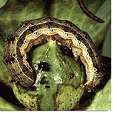
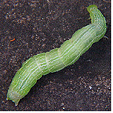
The larvae are smooth and vary in colour but have light coloured strips
Life Cycle
This insect has a Holometabolous life cycle, i.e. it has a larval and a pupal stage.
Females lay up to 1000 tiny white eggs, deposited singly, on the young growth of host plants.
Larvae pupate in the topsoil, after feeding for 2-3 weeks; the emergence of adults is triggered by appropriate moisture & temperature conditions during Spring. Long periods of cold and drought can delay the emergence of the adult moths for up to 5 months.
There are two main periods of infestation early summer and autumn.
Distribution of the Pest
Helicoverpa species (Heliothis species) are found throughout Australia.
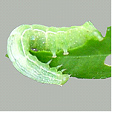
Larvae have prominent prolegs
Period of Activity
Most active in Spring and Summer, after good rainfall and vigorous plant growth.
Damage Caused
Larvae attack chew on new growth, fruit, seed and flower buds. Fruit and flowers are damaged and yield is reduced. Entry holes in fruit enlarge and become more obvious as the caterpillar matures.
Bud worms which feed inside the flower buds can cause the buds to brown and not open.
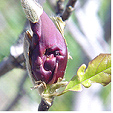
Damage to a flower bud
Susceptible Plants
Attacks a wide range of fruiting and ornamentals plants, such as gardenias, carnations, roses, calendula, hollyhocks, snapdragons, etc. This is a major pest of commercially grown tomatoes, beans,
sweet corn, cotton, sorghum and peas.
Pseudotsuga menziesii, Picea, Pinus, Pseudolarix and Tsuga species are attacked by the Spruce Budworm (Choristoneura fumiferana). Symptoms include the new opening buds and needles are eaten by the dark red caterpillar that has a yellow stripe along its side. It is a serious pest to ornamental and forest trees and control is difficult.
Control
Cultural Control
It is difficult to control bud-worms once they enter the fruit or buds so it important to apply clay and pepper sprays or pyrethrum, while the young lava are feeding on the leaves. Caterpillars may be removed by hand or infested flowers and fruit removed from the plant.
Biological Control
Genetically modified crops have been developed for cotton.
A virus NPV may be commercially available for cotton growers to control Helicoverpa armigera and H punctigera
Helicoverpa armigera & Helicoverpa punctigera), are parasitised by many different insects, including Chaetophthalmus dorsalis flies from the Tachinidae family.
Egg parasites include Trichogramma & Telenomus wasps
Larval parasites include Micrropilitis demolitor, Netelia producta and Trachnid flies
Larval pupa parasites include Heteropelma scaposum and Lissopimpla excelsa
Pupal parasites include Ichneumon promissorius
Chemical Control
Control needs to occur before the larvae enter the fruit or flowers.
Note
It is your responsibility by law to read & follow the directions on the label of any pesticide
Monitoring
Shake plants twice a week on to a stiff white cardboard, once they start flowering.
Other Common Names; includes
Native Budworm (Helicoverpa punctigera) Tomato grub, Cotton bollworm, Corn ear worm, Tobacco budworm
Amendments by B. Sonsie Dip Hort Sc Burnley
PEST
NAME
Two-spotted Mite, Red Spider Mite
Tetranychus urticae
ORDER
Acarina
FAMILY
Tetranychidae
Description of the Pest
Also known as the red spider mite. Females are pale green or yellowish, depending on the host plant, and have two dark lateral markings; the mite becomes red in winter, retaining their dark markings. Nymphs are six-legged, with another pair of legs appearing as the mite matures. Males are smaller and narrower. Fully-grown adults are just visible to the naked eye. Two-spotted mites spread by crawling between nearby plants or movement of dead leaves.
Appearance and Distribution of the Pest
Found world-wide; an introduced pest in Australia. They congregate in protected places, such as under bark and at the base of trees, during winter. During spring, they become green in colour, and migrate back into the leaves. During heavy infestations, the leaves may be covered in visible webs, which they spin as they feed. Leaves may eventually wither and fall. Mites can spread via the movement of dead leaves, or in webs that have become attached to birds or large insects. They initially appear on the undersides of leaves.
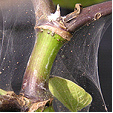
Spruce Spider Mite (Oligonychus ununguis) is a tiny greenish black adult which lays eggs on twigs where they overwinter. The pale green young spiders suck the sap turning the leaves yellow to brown. Heavy infestations form webbing and the pest is found on Abies and Juniperus species.
Banana spider mite (Tetranychus lambi) is a major widespread pest of bananas. It differs from two spotted mite by not producing copious amount of webbing. It is highly active during the dry spring to summer period and with the onset of the wet season mite numbers are reduced. The warm dry conditions that are created under plastic bunch covers is ideal for building up banana spider mite numbers.
Damage is normally confined to the underside of leaves appearing as rusty patches that coalesce along the leaf veins eventually turning the whole leaf brown-grey before it collapses. Fruit is damaged, close to the bunch stalk causing the area to become dull red purple-black, which in turn becomes dry then cracks.
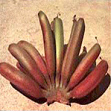 Damage fruit
Damage fruit
Control methods include careful water management during dry periods, and the reduction of dust from roadways. Regular desuckering and leaf trimming of plants will assist with a good coverage when spraying miticides.
Life Cycle
Mites have a gradual metamorphosis, with several nymphal stages. Each female lays up to 100 eggs that hatch in 7-14 days, with several generations appearing throughout the year. Females may become inactive during cold weather.
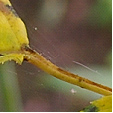 Webbing
Webbing 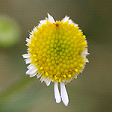
Period of Activity
The Two-spotted mite is most active in hot dry conditions. Under optimum conditions, the population can double every four days. It produces large quantities of webbing for over-wintering nests. Many plants are only susceptible to this insect when cultivated under glass.
Damage Caused
Adults and nymphs lacerated the undersides of the leaves with there rasping mouth parts, although infestations on both surfaces are not uncommon. Infestations cause leaf mottling leaf fall; premature leaf loss causes loss of vigour and reduces the quality and quantity of future crops. Repeated infestations, year after year, may weaken root growth and kill herbaceous plants.
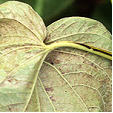
Susceptible Plants
A wide range of plants are attacked by the Red Spider Mite including annuals, fruit trees and vegetables, ornamental shrubs and trees.
Note
Many plant species are more susceptible to Red Spider Mite when they are cultivated under glass.
Other species of mite that are mentioned below have simular characteristics.
Calluna, Rose, Tropaeolum and Viola and species are infested with the Red Spider Mite (Tetranychus telarius) commonly in greenhouse situations.
Musa species are attacked by two spotted mite and banana spider mite damaging foliage and fruit.
Juglans species can be infested with up to four types of mites including red spider.
Cultural Control
Heavy rain or irrigation can reduce numbers; some plants may benefit from replanting in cooler locations. Generally, however, infested material should be completely removed and destroyed.
Preventative measures such as removing weeds or mulching around trees or shrubs or scrubbing the loose bark of susceptible trees during winter helps reduce numbers. During spring sticky bands can be wrapped around trunks close to the ground to trap the mites.
Biological Control
Natural predators include lacewings, ladybirds and thrips help keep the numbers down. Insecticide-resistant predatory mites (Typhlodromus occidenyalis) are also available commercially to control the Two-spotted Mite only on a large scale, as they require ample mites to survive.
Chemical Control
Spraying should be carried out as a last resort as many predators are killed during the operation and spraying can have the opposite effect by increasing numbers in the long term. Dimethoate will reduce numbers; however, Two-spotted mites are resistant to insecticides in some areas. Dusting with wettable sulphur may also prove effective.
Note
Always read the label for registration details and direction of use prior to application of any chemicals.
Average Lowest Temperature : -1º C 30º F
USDA : 8, 9. 10, 11
This USDA (United States Department of Agriculture) hardiness zone chart can be used to indicate a plant’s ability to withstand average minimum temperatures. However, other factors such as soil type, pH, and moisture, drainage, humidity and exposure to sun and wind will also have a direct effect on your plant’s survival. Use this chart only as a guide, always keep the other factors in mind when deciding where, when and what to plant.
A plant's individual USDA zone can be found in the Plant Overview.
Climate Description
Warm to Sub-tropical
This overlaping zone has ample rain with high summer temeperatures and high humidity. Winters are mild. Pockets of sub-tropical climates exist within coastal warm temperate zones.
Frosts and droughts rarely occur along the coast.
Plant growth
Tropical and warm temperate native and exotic plants grow well.
| Dictionary | Growth Habit |
| Leaf Type | Botanic Flower Description |
| Leaf Shape | Flower Inflorescence |
| Leaf Arrangement | Fruit Type |
| Leaf Margin | Bark Type |
| Leaf Apex And Bases | Flower Description |